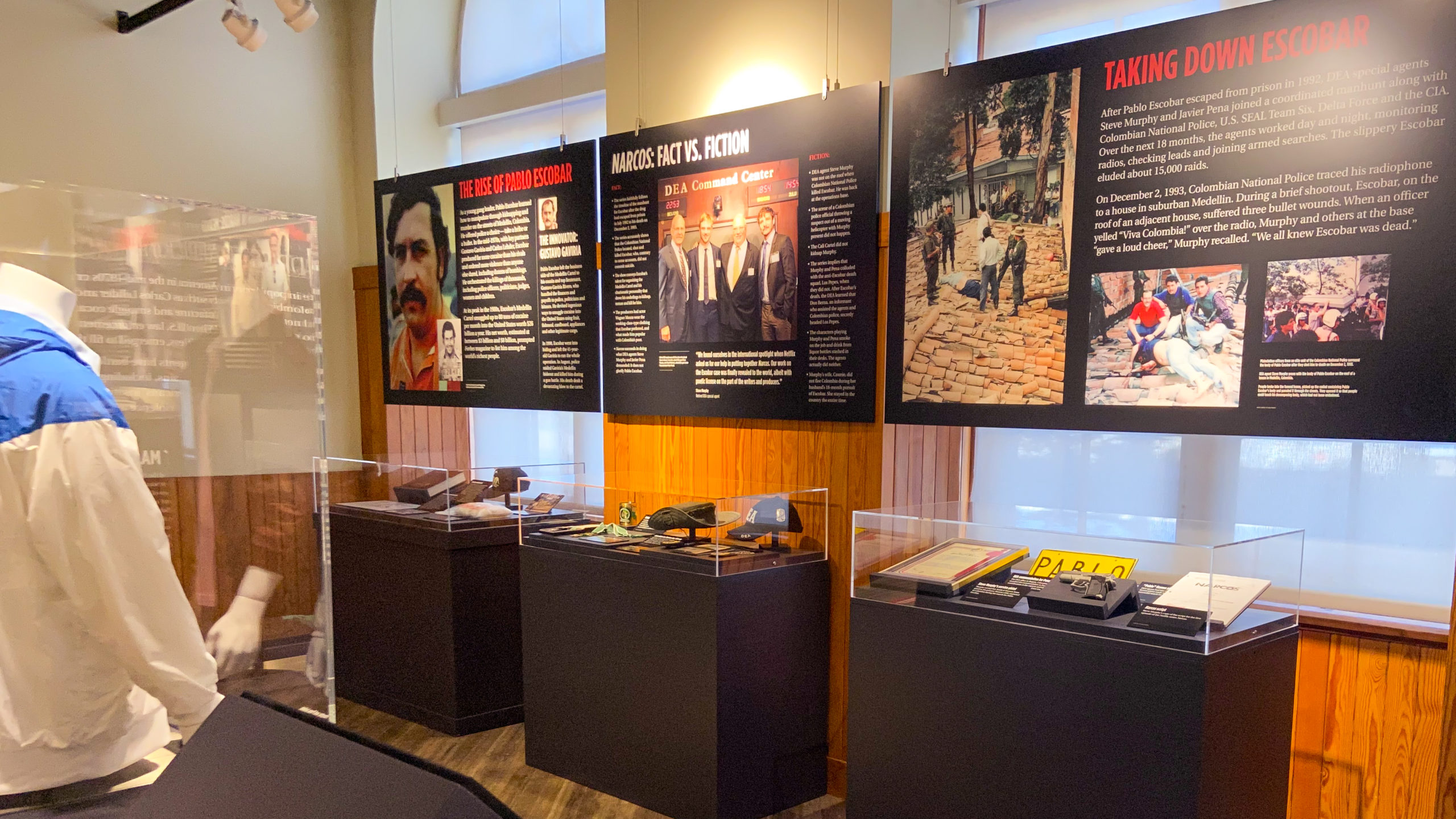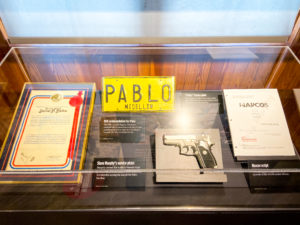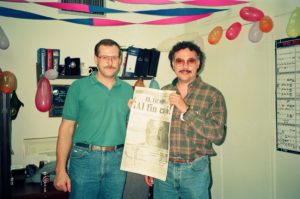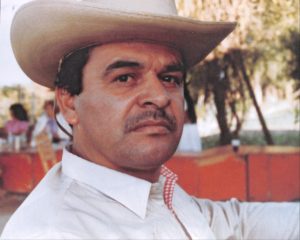Mob Museum debuts ‘Rise of the Cartels’ exhibition
Artifacts include many from ex-DEA agents whose lives were dramatized in the Netflix series ‘Narcos’ and ‘Narcos: Mexico’

Pablo Escobar, the ruthless Colombian drug kingpin and world’s first billionaire criminal, pioneered mass-market drug trafficking, fueled by bribery and murder, in the mid-1970s. His legacy is still unfolding today.
Escobar’s strategy more than 40 years ago of smuggling tons of cocaine from Colombia into the United States remains a staggeringly successful, and frustrating, reality, if done somewhat differently now. Since the 1980s, Colombia, which produces more cocaine than any other country, has outsourced through Mexico’s drug cartels its secret exports into America — by land, air and sea. The annual proceeds, divvied up among the Latin American crime groups, amount to $19 billion to $29 billion, according to the U.S. Department of Homeland Security.
The exploits of the late Escobar, his former Medellin Cartel, his henchmen, his heinous crimes and criminal successors make for a fascinating tale, and the subject of the Mob Museum’s latest major exhibition, Rise of the Cartels: International Drug Trafficking in the Americas, which debuted June 20.
The exhibition tells the story by weaving true stories and artifacts with contemporary pop culture narratives about the clash of the Colombian and Mexican cartels with the U.S. Drug Enforcement Administration, as showcased in Netflix’s popular series Narcos and Narcos: Mexico. Key to that story are the DEA’s special agents assigned to dangerous parts of Mexico and Colombia, who risked their lives to pursue Escobar and other infamous traffickers.
One such agent highlighted in the exhibition is Enrique “Kiki” Camarena, who, after busting marijuana ranches in central Mexico, was kidnapped, tortured and murdered by conspirators that included Guadalajara Cartel boss Miguel Felix Gallardo, in 1985. Camarena’s death led the DEA to pull out the stops to find his killers. The effort ended in more than 30 arrests, including Gallardo, later convicted of murder, and the collapse of Gallardo’s cartel.

To assist in producing the exhibition, the Mob Museum enlisted former DEA agents whose work in Colombia and Mexico in the 1980s and 1990s is dramatized in the Narcos series.
The first two seasons of Narcos depict the timeline chronicled by DEA special agents Steve Murphy and Javier Pena in their 2019 book Manhunters: How We Took Down Pablo Escobar. Murphy and Pena worked alongside Colombian National Police – on raids, investigations, interrogations — in the search for Escobar in Colombia from 1992 to the drug lord’s violent death by police in 1993.
Both Murphy and Pena provided valuable background information and artifacts saved from their careers in the DEA. Artifacts include the former agents’ DEA badges they wore while serving in Colombia, the Distinguished Service Crosses awarded to them after Escobar’s death, a wanted poster for Escobar, cocaine bags seized from his drug lab, Murphy’s 9mm firearm and a Los Tombos hat like those worn by members of the Colombian Police’s elite Search Bloc unit.
Murphy and Pena say the producers of Narcos took a number of liberties in the show to move the storylines along, including scenes involving their characters that never happened. On one of the panels in the exhibition, Murphy and Pena explain what things the show got exactly right and what amounted to dramatic license. Overall, they both believe Narcos succeeded in bringing the requisite points of their narrative to light.
Former DEA agent Pete Hernandez, who graduated from the DEA Academy with Camarena, served with him in Guadalajara and became his close friend, delivered for the exhibition the cowboy hat he wore while with the anti-drug agency in that city from 1979 to 1983. Hernandez also furnished a photo showing him and Camarena in the Zacatecas Mountains of central Mexico.
Another colleague of Camarena’s, former DEA special agent James “Jaime” Kuykendall, furnished a photo for the exhibit of a sign from the Rancho Santa Fe, a marijuana ranch that he and Camarena helped raid in 1983, resulting in one ranch hand shot to death by police. Kuykendall also made available a photo of him posing beside seven-foot marijuana plants at a trafficker’s farm in Mexico in 1992.

Kuykendall is himself an important character in Narcos: Mexico (portrayed by actor Matt Letscher), shown working as a DEA supervisor alongside Camarena (played by Michael Pena). He and Camarena were good friends in real life. Kuykendall served as the source for the exhibition’s panel on fact vs. fiction in Narcos: Mexico.
Two artifacts in the exhibition come from the Museum’s collection. One is a copy of a rare leather-bound book, commissioned by Escobar, containing a collection of editorial cartoons about him from Colombian newspapers. Escobar had a limited number of the books printed, and only 10 are believed to still exist today.
There is also a security officer’s ball cap from Escobar’s Hacienda Napoles, a ranch and theme park that was home to an array of exotic animals, including hippos, elephants and giraffes.
The exhibition portrays the beginning of Escobar’s career as a drug trafficker in the mid-1970s. A map shows the smuggling route created by his partner, Carlos Lehder, a pilot who bought most of an island, Norman’s Cay, in the Bahamas to use as a stopover to surreptitiously fly loads of cocaine from Escobar’s processing labs in Colombia into southern Florida, where their cohorts fanned out the drugs to distributors. It worked beautifully for several years until Lehder’s capture and the closing of the island in 1983. Lehder, originally sentenced in 1988 to life plus 135 years in a U.S. prison, won release from federal prison on June 15 and now lives in Germany.
The exhibition notes Escobar’s rise as a street hoodlum in Medellin, indulging in kidnapping, murder and police bribery until he happened upon a small cocaine ring. Coming at the time (about 1975) of increased popularity of powdered cocaine among America’s rich urbanites, it was an unbelievable opportunity that would lead to his trafficking of billions in cocaine, plus heroin and other illegal drugs, from Colombia to the United States.
After seizing control of the ring, Escobar vastly increased production of cocaine paste – the “base” for the drug – to make powdered cocaine and used ever-larger low-flying planes to transport more of it than anyone else. Escobar also resorted to more violence than the lessor drug lords dared – wholesale murder and terrorism, such as ordering the downing of a passenger airliner in 1989, innumerable bombings, the assassinations of Colombian Supreme Court judges, a presidential candidate, a cabinet minister, and paid hits on hundreds of police officers, amounting to literally thousands of deaths. His goal was to intimidate and promote fear within the public and police and discourage government officials from agreeing to sign a treaty with the United States for the extradition of wanted criminals like him.
Escobar’s exploits could not last. The exhibition shows his dead body on the roof of a house, the fatal result of a shootout with Colombian National Police in suburban Medellin after police intercepted his radiophone message from one his hideouts on December 2, 1993.

The dramatic focus of Narcos: Mexico is Miguel Felix Gallardo’s difficulties in maintaining control of his massive illegal drug business, in person and by phone, on the road and in the air, consisting of a confederation of “plazas,” or trafficking territories, in Mexico. Gallardo’s claim to fame was making a major deal with Colombians to supply him with tons of cocaine bound for the United States, smuggled by his coterie of plazas. Amid the tensions, in addition to assuaging corrupt politicians and police, he dealt with the competing personalities and egos of his partners, male and female, and their intervening family members.
Meanwhile, the DEA and Mexican authorities targeted Gallardo and his partner Rafael “Rafa” Caro Quintero for their complicity in the torture-murder of Camarena. They arrested Quintero in 1985 and obtained a murder conviction in court. Gallardo lasted longer, having cut deals with high-level Mexican officials, until his arrest in 1989 and subsequent 40-year prison sentence. (Quintero was released from a Mexican prison on a technicality after serving 28 years, and he remains a fugitive from American prosecutors). With his downfall, Gallardo’s drug federation split into separate cartels, triggering a years-long armed conflict among criminals, called the Mexican Drug War, which has taken the lives of more than 100,000 people since the 1990s.
Today, after the bloody years since the splintering of Gallardo’s Guadalajara Cartel, Mexico’s drug cartels, more or less, include the Beltran-Leyva, Gulf Cartel, Jalisco New Generation, Juarez, La Familia Michoacana. Los Zetas, Sinaloa and Tijuana/Arellano Felix. All owe their existence in many ways to what Escobar started 45 years ago, nurtured and killed for until his inevitable demise.
Feedback or questions? Email blog@themobmuseum.org





